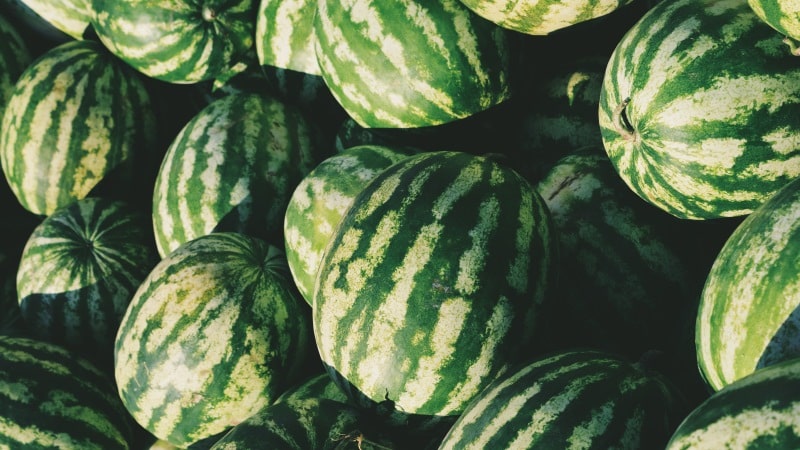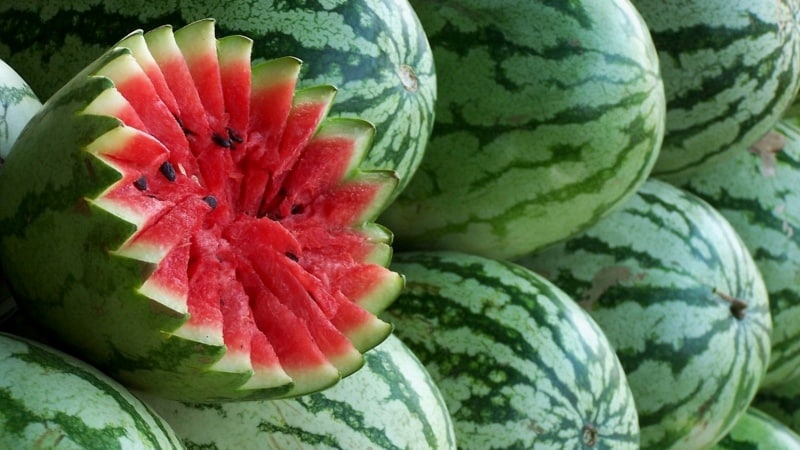When do watermelons ripen and how to determine their degree of ripeness?
Watermelon is loved for its unique taste and healthy qualities. Its regular use has a positive effect on the health of the heart and blood vessels, normalizes blood pressure, improves digestion, skin and hair condition, relieves inflammation, supports the immune system, and helps cleanse the body.
In order for watermelon to bring maximum benefits, you need to be able to choose it correctly. Knowing when watermelons ripen and what ripe fruits look like, you can fully enjoy the berry. We will understand the intricacies further.
What time do watermelons grow?
Watermelon is a heat-loving crop. Most varietiesTo grow, you need warmth and sun. Cold and abundant rainfall, lack of light will not allow the fruits to form and ripen correctly, gain sweetness and reach the size characteristic of the variety.

How long do they ripen?
On average, the growing season of watermelon is 120-150 days. Early varieties will take 60-65 days from emergence to ripen. Mid-season varieties ripen within 60-80 days. Late varieties will require a minimum of 90 days.
From the moment the ovaries appear until they fully mature, it usually takes 30-35 days.
What affects the ripening time
The ripening time directly depends not only on the variety, but also on the growing region. In the south of Russia, the climate for striped berries is optimal: long summers, lots of sun, moderate humidity, warmth. The temperature required for proper growth and development of fruits is +25-32°C, although they germinate seeds at +15-17°C.
In the middle zone, it is more advisable to choose early and mid-ripening varieties so that the plant has time to form fruits, and they have time to ripen. Another way is growing in greenhouses.
Depending on the variety, the size of the fruit varies from 1 kg to 10-12 kg. Typically, watermelons in the middle zone are smaller than those grown in the southern region.
Reference. Define presence of nitrates in watermelon not difficult. Place a piece of pulp in a glass of clean water. If, after lying in the water, it does not color the liquid and has a subtle pinkish tint, everything is in order. If the color is saturated, the watermelon can harm the body.
At what period do they ripen?
Ripe watermelons can be found in almost any summer month. Today, many early and ultra-early varieties have appeared, which can significantly increase the watermelon season. But when choosing, you should consider some features.
When do watermelons ripen in the south?
For example, the ripening period for Krasnodar watermelons grown in open ground is early August. Mid-season varieties are ready for consumption in July. There are also super-early varieties that reach maturity in these places at the end of June. At the beginning of summer, high-quality Astrakhan watermelons of early ripening varieties are found.
Experienced gardeners advise not to rush into purchasing melons. The most delicious are considered to be late-ripening varieties grown in natural conditions with minimal or no use of chemicals. Such fruits reach maturity in early to mid-August, even in warm regions.
Fruits of the middle zone

In the middle zone, watermelons grown in open ground sometimes reach maturity at the end of July. Especially if the weather was suitable and the variety was chosen early or ultra-early.The latter, under optimal conditions, will ripen at the end of June. But most often melons ripen towards the end of summer in August-September.
Ripening times of watermelons by variety
How long does it take for fruits to grow to maturity? Depending on the variety, the time for the ovaries to ripen will be different:
- early ripening ones will require 30-35 days;
- mid-season varieties ripen in 40-45 days;
- the later ones will need 50-60 days.
How to determine the degree of ripeness of berries in the garden
Signs by which ripeness is determined striped berry in the garden, several:
- the fruit has stopped growing - in general, melons can reach 20 kg, but if the watermelon has stopped growing in size, then after 20 days it is removed from the garden;
- shine of the peel - in a ripening fruit it is matte, as if with a velvety coating; in a ripe fruit, the skin becomes shiny;
- clarity and brightness of the stripes on the peel - in ripe melons, the stripes from blurred become clearer and brighter;
- drying of the tendril, located in the same bosom as the tail: drying of the tendril - the fruit is ready for cutting;
- a dry, but not dried out tail - a completely dry tail indicates that the fruit is overripe, a green one indicates that it is immature;
- sound - when squeezing a ripe berry, you will hear a slight crackling sound, and if you knock on a watermelon, the sound will be dull, not ringing;
- A ripe fruit has a yellow side where it lies on the ground.

Choose ripe fruit when purchasing
When buying a watermelon at the market or in a store, they pay attention to almost the same criteria as when choosing a berry from the garden:
- the place where it lay is too large, in the form of a light spot, indicates that the conditions were not very suitable, a small yellow spot is evidence of ripeness;
- if you tap the berry, the sound is loud, and when squeezed, the fruit cracks slightly;
- the peel is shiny and elastic, it cannot be easily damaged;
- the stripes are bright and clear.
When choosing, relying on the dryness of the ponytail is a dubious undertaking. It is often dry and when mechanically cut from the bush ahead of schedule. It dries in literally three days. But by paying attention to its very tip, you will understand whether it has been cut off or has dried out and broken off on its own. Although, there is also a danger in choosing a low-quality product. Dry tails often appear on overripe fruits.
This is interesting. A folk sign for choosing a ripe watermelon: if the rind is damaged by birds, the fruit is definitely ripe. It has been noted that crows, and other birds, do not try to open tasteless and unripe berries.
Girl boy
Many gardeners believe that girl watermelons are sweeter and juicier than boy watermelons. How to distinguish them if the sex division of fruits is conditional? Carefully examine the spot in the place where there used to be a flower from which the fruit was formed.
A large and flat spot is characteristic of the “female sex,” while a small and convex spot is characteristic of the “male sex.”
Interesting. There is an opinion that watermelons, like melons, ripen easily after cutting, but experienced vegetable growers do not recommend doing this. Unripe watermelons contain substances harmful to humans and can easily be poisoned. Cut fruits do not “arrive” very readily, especially if they were picked long before ripening.
Such different weights

How big do watermelons grow by weight? The range is quite large - from 10 to 100 kg. The largest fruit in Russia is considered to be weighing 61 kg. The world record is 159 kg.
By variety, the weight of the berries looks like this:
- Astrakhan - 8-10 kg;
- Madera variety – 6-8 kg;
- beloved in the middle zone, Ogonyok grows up to 2 kg;
- The Sugar Baby variety weighs on average 4 kg;
- Charleston Gray, average weight - 12 kg.
Read also:
Is watermelon a diuretic or not?
Is watermelon good for the liver and can it be eaten if you have liver diseases?
Conclusion
Now you know how to determine the ripeness of a watermelon. To choose a high-quality fruit and fully enjoy its taste and benefits, pay attention to its main characteristics: stain, sound, peel and stripes.
It is better to buy watermelons from trusted sellers; in other cases, do not hesitate to ask for a certificate or documentation from the sanitary and epidemiological station.
Who wrote this bullshit..?
Introduce yourself hero...
Apparently there are several writers...
And what they write: “the sound is crackling... and if you knock on a watermelon, the sound will be dull, not ringing”
And here, just below: “if you tap on a berry, the sound is loud, and when squeezed, the fruit cracks slightly”
Then it’s easier, but nothing is clear: “The definition of nitrates is pulp. If, after lying in the water, it does not color the liquid and has a subtle pinkish tint, everything is in order. If the color is saturated, then...”
— A barely perceptible shade, why the pulp..? If... - What color turned out to be saturated, - pulp ..?
Well, in general, this article is kind of bullshit
Sorry, I'm answering this to myself. Sorry for the harsh words. It’s just that this kind of thing happens so often these days - “the leg should be dry, but not overdried.” This is on what scale and what device is used to determine the difference between Dry and Overdried.
So . Please do not be offended. I have no way to correct harsh words, so there is no editing here. Please rewrite the article